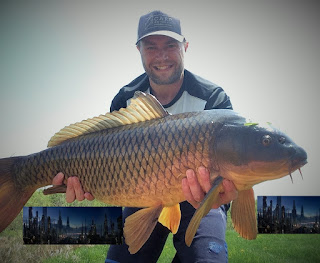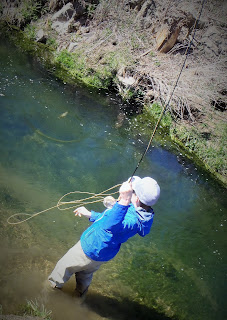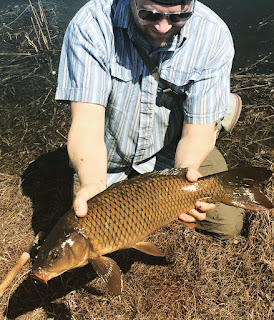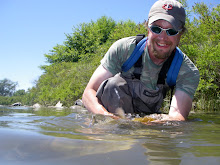May 18, 2018 Report from the Local Water and a Day to Remember
Lesson: personal milestones are cool but the true joy probably comes from sharing fishing with others. This is known to many but always worth re-stating.
Episode I. Pond I have fished many times; in fact have become very well acquainted with the carp. I think it's a relatively sparsely populated system. As such I have watched these fish get bigger. Just after ice out I started looking around various pond systems; in this one I took note of big sow fish. Wide and putting on even more weight leading up to spawn. They have a history of just stoning me silly but I got a 19 lber to hand early on and that got me thinking I could get these fish in the aquarium settings. They have a habit of what I call "wary feeding" meaning they are in fact looking for food, but they are not digging or mudding; rather they kind of dip and lightly feed now and again, along some slowly-traveled path. This is maddening for the sight fisherman because they balk at any movement on shore, the rod waving, the line extending. The line hitting the water and the fly sinking within their sight goes even further: blows them up and sends them off. What is needed is the right wind direction and a careful study of one corner of the water. On this day that pattern/habit indeed held and I found maybe 6-7 fish feeding heavy; by their own activity affording me some cover in the form of silt plumes and turbid water. But the main deal was that they were happy and they weren't going to spook at my every movement. I studied and studied and looked some more because to be honest I didn't want to hook a small fish. Snobby sounding but the reality is that I would only get one out of here and this was such a periodic and difficult find; didn't want to burn it on a small fish. I'd been fishing light flies to the wary fish - trying slow sinks - hadn't worked. So I switched to what I believe is the best general fly pattern for MN hard tailers: LOD or something thereabouts. Sinks pretty fast so you can get it where you want it easily; some substance and little flash to it so fish with heads buried can still see/sense it; and it looks like a lot of organisms in our waters. I did spook a couple fish even with all the good cover. Started to fret a bit thinking that maybe the group would disperse so I resolved to put the fly on the best-positioned fish regardless of perceived size. Did that and it ate on the first presentation. I couldn't see the fish head or the fly. I put it where it needed to be and saw something in the tail movement that made me think eat. Picked up and fish on. Fish did not look really big while fighting. Nor did it run great distance. Fairly standard fight and somewhat easier to net than the 19 lber from a couple weeks earlier. But when I got the fish close I started to study the distance from the tail breaking the water to my point of connection. Looked long. In the net looked long and felt heavy. We've weighed many many fish and as I hooked the scale on the net I knew it was 20+ lbs.
 |
| Long clean heavy mean fish. |
 |
| Tare on net is 1 lb. |
Episode II. Later joined by Winona Fly Factory; his interest was in finding some bigger (than trout) fish and he probably took note of 14, 17 and 19 lb fish on fly gear all caught over the span of a week or two without leaving home. No gear needed; no boat; no hassle really. No long drives in traffic. Just big fish that eat flies. This was of interest to him so we went out and looked around, skipping the pond that just gave up the 22 lber. Different systems; kind of a “carp circuit” in that way. The first good target we saw was memorable: we spotted a cruising fish across the pond – solid big fish doing the horse-head swing – looking for food but not tailing hard in any one location – searching along the shore. As if we had extended an invite the fish broke off the shore path and swam straight at us. I think I swore a fair bit and whispered exclamations like that fish is going to eat the hell out of your fly so be ready, etc. WFF put the fly on the fish as it faced us directly at approximately 1.5 rod lengths. The water was moderately turbid but the fish saw the fly. WFF kind of moved it around trying to get an eat; the details are not crystal for me other than I recall the great white mouth moving about trying like hell to eat that fly. But it’s not always easy even on great shots. Just couldn’t connect. We laughed about it and moved along as did the carp. A couple more shots came. I was reminded to not take the drag and drop technique for granted. It’s nothing to do with trout fishing; it’s a whole different deal and it takes some honing I guess. WFF is about as good an angler as you will find but he needed some trial to get the carping edge back (he fished Columbia with us way back when). The irony is that the fish he ended up hooking was probably the most difficult target of the outing: we spotted at distance a great waving tail. Not breaking the water for it was fairly deep – probably 2.5-3 feet. Prominent bubble and silt plume – just a very happy fish hammering away at the pond bottom. I suggested to WFF that he should go Zen on this deal and understand that he would be afforded no strike and no visual of the fish head or fly; he’d need to drop it where he figured the head would be, count down according to known sink rate, and then just pick up the rod – this in sum constituting not a “guess” but rather an attempt based on the best available information and observation. He did as much and the first few presentations were not hookups; in fact at least one bumped her and moved her but she was so happy she didn’t spook – she just moved. On maybe the fourth or fifth such attempt he came up with a bowed rod. We studied with a bit of anxiety the fish moving about but it didn’t take long to see the fly right in the lip. Absolutely beautifully done. Being a special fish for WFF I basically just let him play it as he saw fit; he took great care and time landing it. There was one tippet knot in the leader. I had no mind to rush him. With the fish in the net I could see it was 20+ lbs. We weighed it 3-4 times and concluded that it was pretty much right at 22 lbs. Second such fish of the day, from a second pond system. By his own note, a lifetime fish for WFF; congrats man.
Episode III. On the way home my wife indicated that my older son needed something to do. My response/suggestion was that he should grab a long sleeved shirt, a buff, hat, glasses and water bottle. Continue the carping day I was saying. We had only an hour or so of bad light left. But he was ready when I pulled up and we just continued on to yet a third pond system. I gave him a little coaching en route, noting that while he had caught many trout on the fly and many carp on spinning gear, he had yet to marry up the carp with the fly rod; as such he would face a bit of a challenge – bigger fish on lighter gear, and no favors (generally) e.g. fish hooking themselves while you retrieve a lure or jig or fish showing the eat by rising to a fly. He seemed up for it and he said as much. Three great targets, as detailed: (1) small fish feeding, facing shore/us; he did a great job with the drag and drop, put the fly right where it needed to be; I watched the fish eat but did not say anything, allowing him time to discern; too late – fish ejected fly and left the vicinity; good lesson and we talked about it, (2) light was bad and as such we noted that in these conditions/times it is often best to key on bubbles and silt plumes; the first bubble trail he saw got a presentation and he put the fly where he figured the head would be; jig it just once or twice I told him because the water was a little turbid; he did so, and picked up the rod either on a jig motion or just by instinct, and found the fish on; very happy moment; very faith-based deal there for a young kid; we were a little bit happy; 5 lbs scaled, (3) another small fish facing us just as dark was coming on – very hard to see – he put the fly out maybe a foot and the fish saw that thing and started finning forward very excitedly; but then a couple inches away from the eat we humans were also perceived and the carp did a 180 thus ending our carping for the night. He went on and caught a bass and a crappie while I studied some more of the water. He made some remarks on the way home indicating that he is intrigued by carp on the fly. As well he should be; 5 lbs is his heaviest fish on the fly (which probably already has him in the top 25% of fly anglers worldwide in terms of biggest fly caught fish); not for long though I’d say.









































